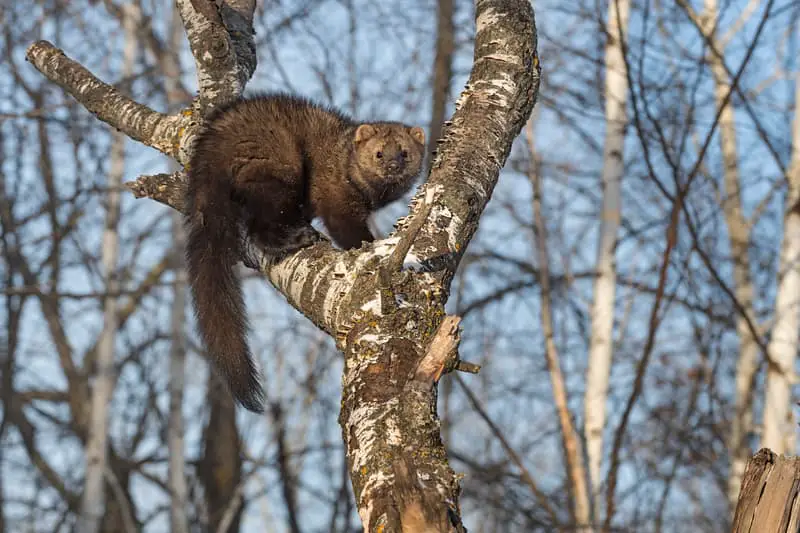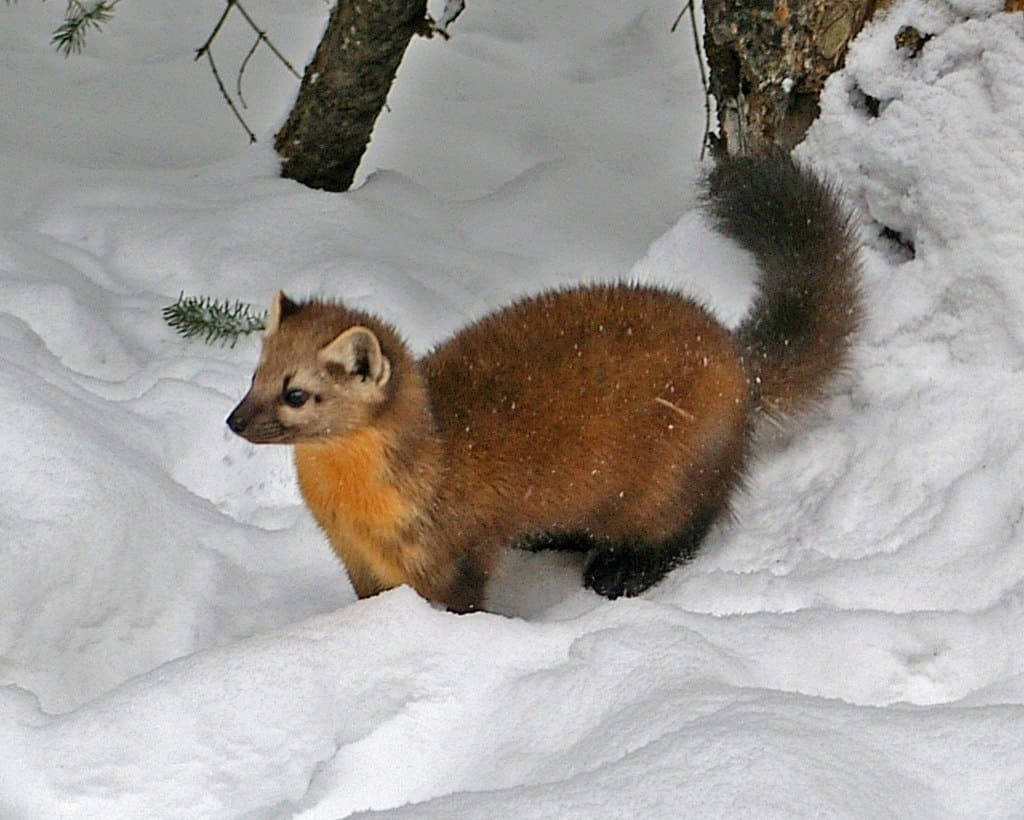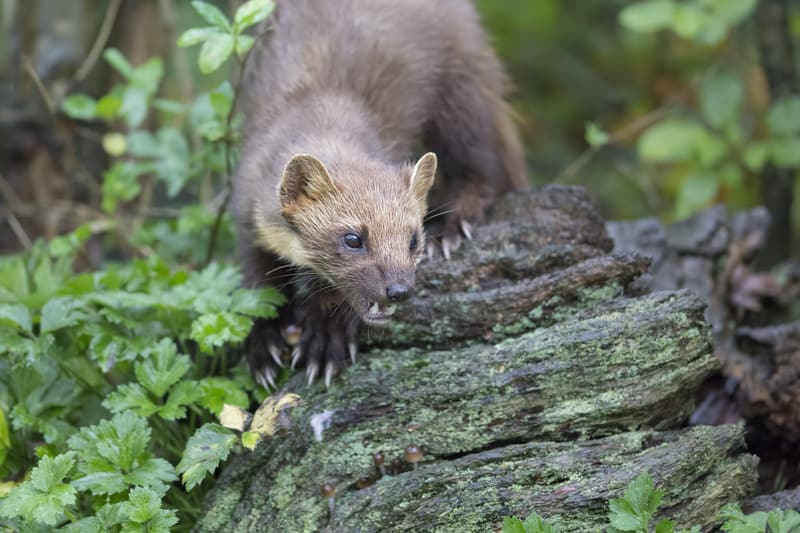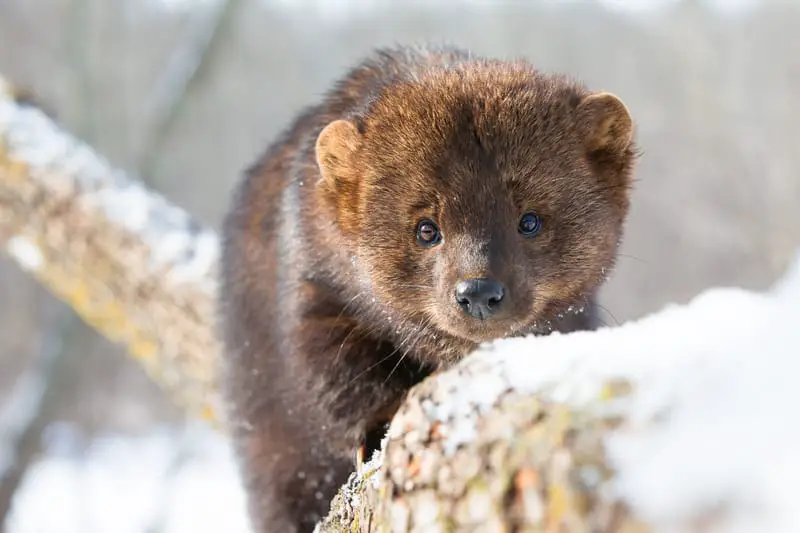Martens belong to the Weasel family. People often mistake pine martens for fishers, a close relative that belongs to the mustelid family. Fishers reside in almost the same habitats as martens, and their tracks are almost identical. The difference between pine martens and fishers is that the latter is considerably larger, and their fur is darker than martens. Besides, martens also have two thick black vertical lines that run from the top of their eyes to the forehead. Furthermore, the ears of pine martens are larger than those of fishers. The purpose of this article is to illustrate the characteristics of fishers and pine martens.
What Is a Fisher Cat?
Fisher cats (Pekania pennanti) are tiny mammals, usually dark brown in color, belonging to the weasel family (Mustelidae). Also known as fisher, black cat, or pekan, these animals mostly reside in forests in Canada and the United States.

What do fisher cats look like?
The fisher is almost similar to the marten (Martes americana) but is slightly larger in size. They are long, thin-bodied animals covered in fur with low rounded ears, a tapered muzzle, and have a bushy tail. These creatures are sometimes confused with cats, but they are not closely related at all.
Fishers do not eat fish. They are one of the largest members of the weasel family, which includes the marten, weasels, mink, and otters—their fur changes in color from one season to season to the other. During winter, their coat is dark brown, while in summer, their coat lightens.
Fisher’s dark fur makes it more difficult to spot them at night. These animals are great at hiding in bushy plants and hollowed trees. They are well known for their sounds that resemble a child screaming, which can sometimes be mistaken for someone crying out for help. Their dark fur makes it difficult to spot them during the night.
Male fishers have a light coloration on their face, head, and shoulders. The fur on males is coarser than that on the females, but both are darkest on the tail and legs. There are two small white patches of fur that are found on the frontal armpit areas. They have 38 teeth, including flat-topped molars, which are useful for chewing, and 4 sharp canine teeth.
These weasel family members are nocturnal and are usually active on the ground, but they also climb on trees where they spend most of their time resting. Fisher cats are solitary except during the breeding season. Usually, their reproductive cycle goes for almost a year, where the female gives birth to about three to four kittens. They take care of their young ones until they are mature enough to go out on their own.
How big do Fisher Cats get?
Also known as fishers, fisher cats are about 32-40 inches long, with the females weighing 2-2.5 kg and the males weighing 3.5-5.5 kg.
What Do Fisher Cats Eat?
The following quote is taken from (All About Fisher Cats)
“Fishers are mostly carnivorous. However, they also eat nuts and berries. This makes them omnivores. They feed on mice, squirrels, snowshoe hares, woodchucks, insects, carrion, and, more importantly, porcupines. Even though porcupines are difficult to kill, a porcupine can serve as a food source for many days for a fisher. Fishers also feed on eggs and baby birds.”
Snowshoe hares
Snowshoe hares are ranked very highly as a preferred meal for the fisher. With very keen senses of sight and smell, the fisher can stalk the snowshoe rabbits. They can also run on top of the snow when they’re chasing them. Red squirrels are also common prey for the fisher.
Porcupines
Several animals eat porcupines, but they’re not the first choice on their menu due to the danger in their quills. Interestingly fisher cats seek out porcupines because they’re skilled and especially suited to hunt and kill them. When porcupines encounter a predator, they bristle up their quills and keep their protected backside towards their attacker. Fisher cats are built low to the ground. What’s more, they’re and quick and nimble. Using these two advantages, they circle the porcupine and dart in to bite, scratch their unprotected face and head until they’re able to deliver a killing strike which probably amounts to crushing their skull.
Porcupines are not usually safe when climbing trees since fishers attack them from the top side. They may be safe from fisher attacks if they are on branches and face away from the fisher or in a good position to hide their faces. Fisher cats move very fast, and with the help of their short legs, they can keep low on the ground. Additionally, fishers have strong claws that are useful for climbing purposes.
Gifted Predators
They have five toes on their foot, and their feet are proportionately large, making it easier for them to run on top of the snow. They also have four central pads on each of their foot and mobile ankle joints, capable of rotating the hind paws at about 180 degrees, making it easier for them to maneuver up and down trees. In fact, the fisher is known to be one of the few species amongst mammals that has the ability to descend trees head-first.
Both male and female fishers are skilled predators. These animals are known to be aggressive hunters. The raccoon may be attacked by a large fisher in trees or even on the ground. Additionally, fishers prey on martens. Fishers will also kill bobcat kittens when their mother leaves them unattended while out hunting.”
Lifespan
Fishers are considered to be among the most effective predators and can live for up to 10 years in the wild.

What is a Pine Marten?
A pine marten is a mustelid, and it belongs to the weasel family. It plays a vital role in a balanced and healthy woodland ecosystem. It also symbolizes recovery and resilience. A marten’s family members include the weasel, stoat, otter, polecat, and badger.
Two types of pine martens exist, the European and the American pine marten. The European pine marten is widespread and native to Northern Europe. The American pine marten is found in Alaska, Canada, the Rocky Mountains, Wisconsin, northern Minnesota, and Michigan. It also lives on the east coast in New York, Maine, and New Hampshire.
Size and appearance
The pine marten’s size is comparable to that of the domestic cat. You can distinguish the pine marten from other mustelids because of its large brown eyes, heart-shaped face, a rich chestnut-brown coat that turns darker in summer, and its slim sinuous body. The pine marten also has a flamboyant apricot-colored bib and long tails that are bushy during winter.
In Europe, people at times confuse the pine marten with the beech marten. The beech marten, also referred to as the stone marten, looks like the pine marten but is smaller.

Which are the habitats where pine martens live?
These animals like living in three-dimensional habitats to use their adept climbing skills to avoid predation and find food. They prefer a diverse woodland habitat with a well-developed shrub and ground layer as well as old trees. However, pine martens are adaptable. If woodland is not suitable or is scarce, they can live in crags, cliffs, rocky mountains, and houses’ roof space.
Pine martens usually do not excavate their own dens. Instead, they prefer using various woodland structures. They usually den in tree cavities, windthrow, squirrel dreys, rock faces, and up-turned root plates. In areas where foxes are found, pine martens are safer if they den in above-ground sites. If natural structures are unavailable, they love to occupy huge bird boxes, old buildings, and purpose-built den boxes.
What is the average litter size of the marten?
Pine martens are slow breeders. Females usually attain sexual maturity when they are three years old. Breeding occurs once a year, and they give birth to 1 to 3 kits in the spring. The kits emerge from their breeding den about mid-June. They become independent of their parents when they are about six months of age.
How long do pine martens live?
In the wild, pine martens rarely live longer than ten years. They are likely to live for less than five years.
What do pine martens feed on?
Martens are omnivorous, and they eat what is available in plenty. Small mammals make up about 40 percent of their diet. During the summer and fall seasons, they are dependent on fruiting shrubs and trees like cherry, rowan, and hazel. Fruits constitute about 30 percent of their diet. They also eat birds and eggs. They also have the advantageous effect of feeding on magpies, jays, and other corvids.
Related Posts:
American Pine Marten – Krebs Creek
All About Fisher Cats – Krebs Creek
Recent Posts
The only venomous snakes in Washington State are Northern Pacific Rattlesnakes. The Northern Pacific Rattlesnake (Crotalus oreganus oreganus) is a sub-species of the Western Rattlesnake. Anyone...
Skunks are not classified as true hibernators. But they go into a state of torpor when the weather gets cold. Skunks are light sleep hibernators, along with opossums, bears, and raccoons. ...

